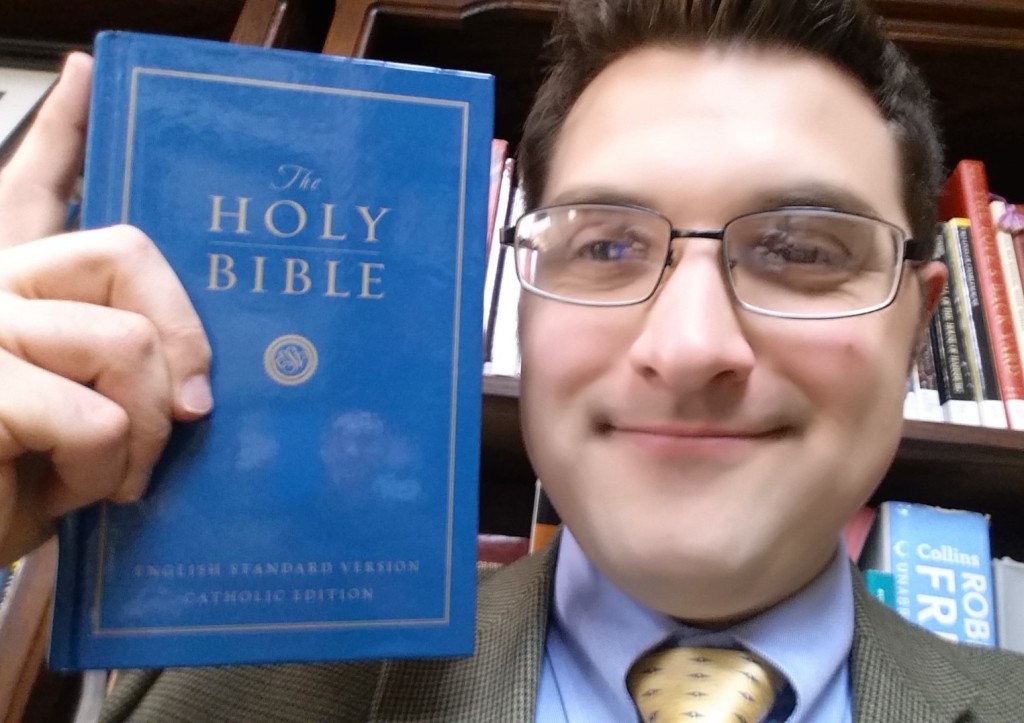I just read the life of St. Catherine of Siena by Sigrid Undset (trans. Kate Austin-Lund; Sheed and Ward, 1954) and I want to consolidate a bit of the information that I learned here in no particular order:
- The famous fact that Catherine miraculously fasted on the Eucharist alone for much of her life was no saccharine act of devotion nor a merely nice favor from the Lord. Rather, she was unable to eat other food without vomiting and considered the miracle a punishment for her sins of gluttony:
“Later Catherine complained sometimes that she wished with all her heart that she could eat like other people, so that she could avoid causing annoyance. When it gave her the most terrible pain to swallow anything, and her stomach could not retain anything that she forced into it , she said that she believed it must be a punishment for her sins, and especially for the sin of gluttony, for she had been so greedy for fruit when she was little.” (p. 96)
- Jesus taught her how to read miraculously. Though she had taken a few lessons in Latin, one day she woke up knowing how to read so she could pray the Breviary. (p. 48)
- As is well known, she had an invisible engagement ring from Jesus on her finger that only she could see (p. 50) and she had the stigmata that no one could see.
- When Catherine would fall into ecstasy, she could feel nothing, so people would kick her to test her (p. 59)
- She would take wine from a wine barrel in her parents’ basement to give to the poor with the meals she brought them and it miraculously lasted many times longer than it should have. (61-62)
- Catherine cared for a leper named Cecca who would insult her violently every time she came to perform her nursing ministrations. Cecca was so covered in scabs and puss that she stank and no one else was willing to care for her. (pp. 70-71)
- Catherine cared for a woman with breast cancer named Andrea. To overcome her revulsion at the patient, against Andrea’s protestations, Catherine touched her mouth to her cancerous sores and even drank a bowl of water that had been used for washing her sores (p. 79). The next day, Catherine had a profound spiritual revelation where she was invited to drink from the side of Christ.
- She converted a man (Niccolo di Toldo) on death row, visited him in his cell, attended his execution and, after whispering reassurances of eternal life in his ear, literally caught his head as it fell from the chopping block. (p. 200)
- Her Letter to Cardinal Gerard de Puy (Pope Gregory XI’s nephew) about the Pope:
“With regard to your first question about our love Christ on earth [the Vicar of Christ], I believe and consider that he would do good in the eyes of God if he hastened to right two things which corrupt the Bride of Christ. The first is his too great love and care for his relations. There must be an end of this abuse at once and everywhere. The other is his exaggerated gentleness, which is the result of his lenience. This is the cause of corruption among those members of the Church who are never admonished with severity. Our Lord hates above all things three abominable sins, covetousness, unchastity and pride. These prevail in the Bride of Christ, that is to say in the prelates who seek nothing but riches, pleasure and fame. They see demons from hell stealing the souls which have been put into their keeping, and are completely unmoved, for they are wolves who do business with divine grace. Strict justice is needed to punish them. In this case exaggerated mercy is in fact the worst cruelty. It is necessary for justice to go hand in hand with mercy to put a stop to such evil.” (p. 141)
- Her face transformed into the face of Jesus (still with Catherine’s voice) in the sight of her spiritual director, Fr. Raimondo (pp. 154-55).
- A quote from another letter to Gregory XI:
“Oh, sweet and true knowledge, which dost carry with thee the knife of hate, and dost stretch out the hand of holy desire, to draw forth and kill with this hate the worm of self-love–a worm that spoils and gnaws the root of our tree so that it cannot bear any fruit of life, but dries up, and its verdure lasts not! For if a man loves himself, perverse pride, head and source of every ill, lives in him, whatever his rank may be, prelate or subject. If he is lover of himself alone–that is, if he loves himself for his own sake and not for God–he cannot do other than ill, and all virtue is dead in him. Such a one is like a woman who brings forth her sons dead. And so it really is; for he has not had the life of charity in himself, and has cared only for praise and self-glory, and not for the name of God. I say, then: if he is a prelate, he does ill, because to avoid falling into disfavour with his fellow-creatures–that is, through self-love–in which he is bound by self-indulgence–holy justice dies in him. For he sees his subjects commit faults and sins, and pretends not to see them and fails to correct them; or if he does correct them, he does it with such coldness and lukewarmness that he does not accomplish anything, but plasters vice over; and he is always afraid of giving displeasure or of getting into a quarrel. All this is because he loves himself. Sometimes men like this want to get along with purely peaceful means. I say that this is the very worst cruelty which can be shown. If a wound when necessary is not cauterized or cut out with steel, but simply covered with ointment, not only does it fail to heal, but it infects everything, and many a time death follows from it.
- Sigrid Undset summarizing Catherine’s views in her first letter to Pope Urban VI
“Justice without mercy would be dark, cruel, more like injustice than justice. But mercy without justice would be like salve on a sore which should be cleansed with the red-hot iron; if the salve is applied before the wound is cleansed it only makes it smart, and it does not heal it.” (p.216)
- Pope Urban VI would insult the cardinals and bishops:
“It was against Urban’s nature to show consideration for anyone, and decisions which were in themselves both good and wise led to nothing because he was so harsh and lacking in tact and the ability to understand men. It was too much for weak men, of more or less good will, who knew in their hearts that the Pope was right and that they ought to cooperate with him, when the Pope demanded, with harsh and angry words, that they should immediately change their way of life and give up all the small comforts they had grown accustomed to, in order to live in a state of self-denial suitable for the strictest ascetic. They were agreed that it was time for a reform within the Church. But if this were the reform…And the language he used when he broke into a rage! “Shut up!” he said to the cardinals. He shouted “Pazzo!”—Idiot—to Cardinal Orsini, and “Ribaldo!”—Bandit—to the Cardinal of Geneva. His electors began to regret their choice bitterly.” (p. 224)
- St. Bridget of Sweden (making a cameo appearance in St. Catherine’s biography) indirectly prayed for the death of her eldest son, Karl Ulfsson, since the Queen of Naples had fallen violently in love with him and both he and she were planning to abandon their spouses so they could marry each other. It would have been the Queen’s fifth marriage. St. Bridget wanted to prevent her son from falling into mortal sin. (pp. 242-43)
- St. Catherine:
“Oh, we see in agony of soul how our sins against God rise and overpower us. I live in sorrow, and pray God in His mercy to take me from this dark life.” (p. 255)
- St. Catherine:
“‘In Your nature, Eternal Divinity, I have learned to know my own nature,’ she whispered in one of the prayers which one of her disciples wrote down while she prayed in ecstasy. ‘My nature is fire.’” (p. 264)



